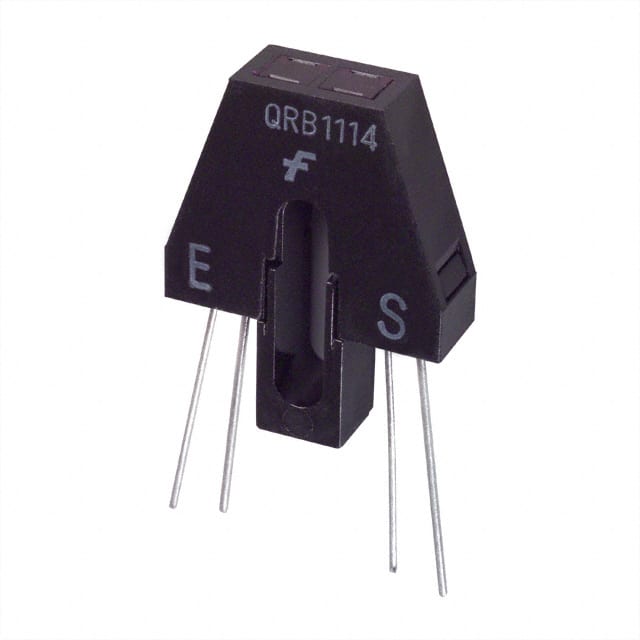QRB1114 - Opto-Electronic Sensor
Introduction
The QRB1114 is an opto-electronic sensor that belongs to the category of reflective object sensors. It is widely used in various applications for detecting the presence or absence of objects, and it offers distinct characteristics that make it suitable for diverse industries.
Basic Information Overview
- Category: Reflective Object Sensor
- Use: Detection of object presence/absence
- Characteristics: High sensitivity, compact size, reliable performance
- Package: Through-hole package
- Essence: Utilizes infrared light for detection
- Packaging/Quantity: Typically available in reels of 1000 units
Specifications
- Emitter Wavelength: 950 nm
- Detector Type: Phototransistor
- Operating Voltage: 1.5V to 1.7V
- Forward Current (If): 60 mA
- Power Dissipation: 150 mW
- Operating Temperature Range: -25°C to +85°C
Detailed Pin Configuration
The QRB1114 features a standard 4-pin configuration: 1. Emitter Anode 2. Emitter Cathode 3. Collector 4. Emitter
Functional Features
- High Sensitivity: Capable of detecting objects with low reflectivity
- Compact Size: Enables integration into space-constrained designs
- Reliable Performance: Offers consistent and accurate object detection
Advantages and Disadvantages
Advantages
- High sensitivity allows for reliable object detection
- Compact size facilitates easy integration into various applications
- Low power consumption enhances energy efficiency
Disadvantages
- Limited range compared to some other sensor types
- Susceptible to ambient light interference in certain environments
Working Principles
The QRB1114 operates on the principle of reflection detection using infrared light. The emitter emits infrared light, which is then reflected off the surface of the object being detected. The reflected light is captured by the phototransistor detector, triggering the sensor's output based on the presence or absence of the reflected light.
Detailed Application Field Plans
The QRB1114 finds extensive use in the following application fields: - Automotive: Object detection in automated car wash systems - Industrial Automation: Conveyor belt monitoring and object counting - Robotics: Line-following robots and obstacle detection - Consumer Electronics: Paper jam detection in printers and copiers
Detailed and Complete Alternative Models
- QRE1113: Similar reflective object sensor with enhanced ambient light rejection
- TCRT5000: Reflective optical sensor with integrated infrared LED and phototransistor
In conclusion, the QRB1114 opto-electronic sensor offers high sensitivity and reliable performance, making it a versatile choice for object detection across various industries.
[Word Count: 398]
Lista 10 Vanliga frågor och svar relaterade till tillämpningen av QRB1114 i tekniska lösningar
What is QRB1114?
- QRB1114 is a reflective object sensor that consists of an infrared emitting diode and a phototransistor.
How does QRB1114 work?
- The infrared emitting diode emits infrared light, which is then reflected off an object and detected by the phototransistor, allowing the sensor to determine the presence or absence of the object.
What are the typical applications of QRB1114?
- QRB1114 is commonly used in line-following robots, edge detection in printers, obstacle detection in robotics, and position sensing in industrial equipment.
What is the operating voltage range for QRB1114?
- The operating voltage range for QRB1114 is typically between 4.5V and 5.5V.
How can QRB1114 be interfaced with a microcontroller?
- QRB1114 can be interfaced with a microcontroller using digital input/output pins to provide power to the sensor and read the output signal from the phototransistor.
What is the typical response time of QRB1114?
- The typical response time of QRB1114 is in the range of microseconds, making it suitable for high-speed applications.
Can QRB1114 distinguish between different colors of objects?
- No, QRB1114 cannot distinguish between different colors of objects as it operates based on the reflection of infrared light rather than color detection.
What are the environmental considerations for using QRB1114?
- QRB1114 is sensitive to ambient light, so it is important to shield the sensor from external light sources for accurate operation.
What are the potential challenges when using QRB1114?
- Challenges may include calibration for varying object reflectivity, interference from ambient light, and proper mounting to ensure consistent performance.
Are there any alternative sensors to QRB1114 for similar applications?
- Yes, alternatives include reflective optical sensors, infrared proximity sensors, and laser-based distance sensors, depending on specific application requirements.


